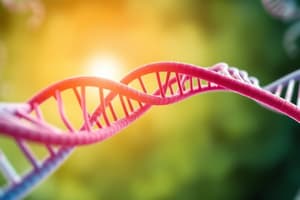Podcast
Questions and Answers
What are the primary RNA polymerases found in eukaryotes?
What are the primary RNA polymerases found in eukaryotes?
- RNA Polymerase I
- RNA Polymerase II
- RNA Polymerase III
- All of the above (correct)
What is the role of the sigma factor in prokaryotic transcription?
What is the role of the sigma factor in prokaryotic transcription?
The sigma factor recognizes and binds to the -35 and -10 consensus sequences in the promoter region.
Eukaryotic promoters are simpler than prokaryotic promoters.
Eukaryotic promoters are simpler than prokaryotic promoters.
False (B)
Eukaryotic transcription initiation involves the assembly of general __________ factors.
Eukaryotic transcription initiation involves the assembly of general __________ factors.
What is a 'preinitiation complex' or PIC?
What is a 'preinitiation complex' or PIC?
During elongation, RNA polymerase II maintains a transcription bubble of 11-15 rNTPs.
During elongation, RNA polymerase II maintains a transcription bubble of 11-15 rNTPs.
How does RNA polymerase I terminate transcription?
How does RNA polymerase I terminate transcription?
Match the RNA polymerases with their functions:
Match the RNA polymerases with their functions:
The ________ binding protein is first to assemble at the TATA box during eukaryotic transcription initiation.
The ________ binding protein is first to assemble at the TATA box during eukaryotic transcription initiation.
Study Notes
Transcription in Prokaryotes
- The sigma factor (σ) recognizes and binds to the -35 and -10 consensus sequences in the promoter region, positioning RNA polymerase for transcription.
- The -10 consensus sequence, rich in A and T, is prone to unwinding due to its AT-rich content.
Transcription in Eukaryotes
- Eukaryotes use three RNA polymerases, each with specific promoter sequences and accessory proteins.
- RNA polymerase I, II, and III are recruited to their specific promoter sequences by accessory proteins that recognize the DNA sequences.
- Eukaryotic promoters are more complex than those in prokaryotes.
- RNA polymerase II promoters consist of a core promoter and a regulatory promoter.
- The core promoter contains the TATA box, recognized by the TATA Binding Protein (TBP).
- The regulatory promoter contains regulatory elements that influence transcription.
- General transcription factors (TFII A, B, D, E, F, and H) replace the sigma factor in prokaryotes.
- TFIID containing TBP is the first to assemble at the TATA box, followed by other general transcription factors and RNA polymerase II.
- These form the 'preinitiation complex' (PIC), which initiates basal (low-level) transcription.
- Transcriptional regulation involves the 'Mediator' complex, which interacts with activator/repressor proteins bound to upstream/downstream regulatory regions or enhancer sequences.
- Assembly of transcription factors and RNA polymerase II unwinds 11-15 bp of surrounding DNA.
Elongation
- RNA polymerase moves along the template strand, leaving transcription factors at the promoter for reinitiation.
- RNA polymerase maintains a transcription bubble during elongation.
- The 11-15 rNTPs in the bubble bend at a right angle, positioning the –OH group at the active site for nucleotide addition.
- Newly synthesized RNA is separated from DNA and exits through a cleft in RNA polymerase.
Termination
- RNA Polymerase I: Requires a termination factor similar to rho factor in prokaryotes.
- RNA Polymerase III: Ends after transcribing a terminator sequence, producing a string of U nucleotides downstream from a hairpin, similar to rho-independent termination.
- RNA Polymerase II: Transcription continues past the termination sequence.
- The RNA is cleaved at a consensus sequence.
- This results in two RNAs: one with a 5' cap and the other with a poly(A) tail.
Studying That Suits You
Use AI to generate personalized quizzes and flashcards to suit your learning preferences.
Related Documents
Description
This quiz explores the mechanisms of transcription in both prokaryotic and eukaryotic cells. You will learn about the roles of sigma factors, RNA polymerases, and the complexity of eukaryotic promoters. Test your knowledge on the key components involved in the transcription process!




